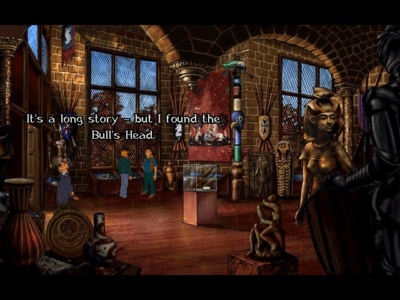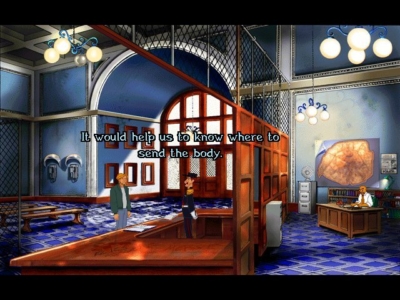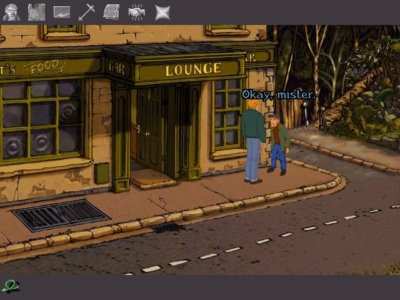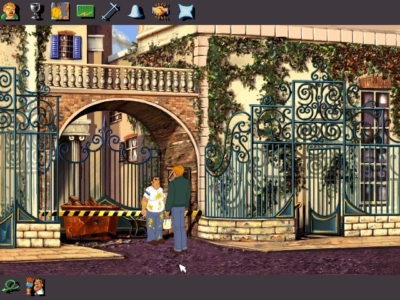
Broken Sword: The Shadow of the Templars
Written by: Rik
Date posted: August 18, 2006
- Genre: Adventure
- Developed by: Revolution
- Published by: Virgin Interactive
- Year released: 1996
- Our score: 6
Without wanting to start another adventure game review by harping on about LucasArts’ glory days, one thing you were usually guaranteed was an interesting, amusing or otherwise entertaining main character. Guybrush, Sam and Max, Ben from Full Throttle, Hoagie from Day of the Tentacle, erm, Boston Low from The Dig (okay, scratch that last one) – they were all pretty memorable for one reason or another. And, generally, adventure games need good characters more than most, with their reliance on a generally quite-repetitive pattern of travelling from location to location, examining objects, using things on other things, and, of course, dialogue, all of which can test the patience of even the most laid-back of gamers. While it doesn’t matter that Gordon Freeman doesn’t say much in Half-Life, and your character in GTA III stomps about silently causing mayhem in Liberty City, in the old-school talkie adventures, you need to be able to get on with your protagonist, because you’re going to be listening to him (or her) talking a lot.
You can probably guess where this is going, especially if you’ve played Broken Sword before. You see, the main man in the game has gained a bit of a reputation for being one of the most irritating adventure game characters of all time, with some even going so far as to claim that his presence in the game makes it almost completely impossible to enjoy. That man is George Stobbart (don’t worry if you can’t remember his name, because George will introduce himself to every character you decide to talk to) and he’s an American tourist (again, this seems to come up in conversation – a lot) who is happily minding his own business when he witnesses a murder and gets drawn into an exciting adventure where he finds a dirty tissue and shows it to everyone he meets.

There’s a pony-tailed twerp at the museum who insists on calling you ‘Georgie’. Frankly, he deserves a punch.
Okay, let’s try and start again. Broken Sword is a serious-ish adventure which sees George Stobbart’s tourist trip disturbed by an explosion at a cafe in the centre of Paris. After narrowly escaping death, George picks himself up and decides to try and solve the case himself, especially when the local police seem disinterested in his testimony (which, admittedly, involves fingering a man dressed as a clown for the crime – to be honest, it’s right up there with The Fugitive‘s one-armed man). The trail leads George around the streets of Paris, around Europe and the rest of the world, involving some alarming brushes with death, a few weird characters and some frankly shocking accents. Without giving too much away, it’s a passable pseudo-historical yarn, which, with its European setting, frequent desecration of museums and ancient artefacts and mention of the Knights Templar, may appeal to fans of The Da Vinci Code (incidentally, Revolution went on to produce the film tie-in, released this year).
I say things like “serious-ish” and “pseudo-historical” not only because I don’t know how to use the English language properly, but also because the tone of Broken Sword is actually fairly difficult to judge. On the one hand, it deals with some fairly serious (and, er, historical) subject matter, but on the other, some of the situations, characters and conversations are all a bit, well, silly really. The story is along the lines of an Indiana Jones/The Mummy romp across several countries, but you spend most of your time engaged in quite slow-paced, if intermittently amusing, conversation with extremely odd characters with dodgy accents. Early scenes in Paris will remind UK gamers of ‘Allo ‘Allo, and, frankly, that’s the general standard of voice-acting you can expect in the rest of the game, too.

Paris’s finest – a bald-headed weirdo and a moustachioed bungler – don’t seem too interested in the case.
Still, this is a computer game, not a Hollywood film, so it’s perhaps a bit unreasonable to expect too much from the accents (despite some potentially-offensive stereotyping). The fact remains, however, that most characters are definitely on the ‘wacky’ side. In fact, almost every NPC could be described as ‘a bit odd’ in one way or another. And then there’s George. Although pretty annoying at times, as a character he’s also fairly inconsistent; initially you picture him as a bit of an ignorant buffoon who you’re supposed to laugh at, but then at other points breaks from this stereotype, occasionally acting aggressively or making alarmingly tasteless remarks – which tends to indicate he’s not intended as a parody. Overall, while you’d like to think the whole thing is rather tongue in cheek, there’s significant evidence to suggest that it probably isn’t. But whether they’re intentional or not, there are certainly some laughs to be had here.
Perhaps it’s time to be a bit more positive. Well, here’s one thing for starters: the graphics are gorgeous. While some may find it difficult to be impressed by 2D graphics these days, it’s hard not to admire the beautifully detailed hand-drawn backgrounds on offer here. The character sprites aren’t quite as eye-catching, but despite occasional blockiness and the odd laboured animation, they’re generally well integrated, with little evidence of characters warping across the screen with legs moving in odd directions, a common problem in adventures. Sound-wise, there’s also some neat reactionary music, with dramatic strings accompanying major developments and significant discoveries. While it’s not always appropriate, and you can be caught off guard when greeted with a flourish after doing something fairly insignificant like opening a window, generally it adds to the atmosphere.
Gameplay-wise, it’s generally enjoyable to play. The interface is quite simple, with the cursor changing to a variety of handy icons when held over an active object, achieved with a simple left-click of the mouse. Conversation topics are also selected by clicking on icons, which is less useful, mainly because it’s not always entirely clear what George is going to say when you click on the icon. Sometimes repeated clicks on the same icon bear fruit, but at others George just ends up repeating himself, which can be amusing (asking people to examine a dirty tissue you acquire early on seems to have almost unlimited comedy value, for example) but is often more than a minor irritation. I have to say I don’t really understand why any adventure wouldn’t give the player a full choice of conversation options, but in Broken Sword you just have to wait and see what George comes out with.
In terms of puzzles, it’s the usual mix of the quite-obvious and the head-scratchingly frustrating. One notable aspect of the game’s structure is that you’re quite often fenced into a particular area and forced to solve a puzzle using only the things you have and the things you can get in the handful of locations available to you. While this makes the game quite linear at times, as far as I’m concerned, anything that cuts down the amount of confused wandering around wondering what to do next can’t be a bad thing. The general pace of the game is quite slow, but things are livened-up somewhat by the occasional threat of death. I’m not a great fan of death in adventure games, but it’s implemented quite well here, with dangerous situations usually signposted obviously enough to encourage you to save your game first.

Disturbing stereotypes ahoy as you chat to a young fella named Maguire outside the traditional ‘Oirish’ pub. He calls you ‘mister’. A lot.
I used to have a big downer on this game, but I have to say that I enjoyed it more than I expected to this time around. Given that the fourth installment of the series has just been released, it clearly has a big following, but as I said earlier, there are also some people out there who find it long-winded and irritating. Those people have a point, and if you’re the sort of person who views adventures as dull old relics better best forgotten, then this certainly isn’t going to change your mind – in fact it might make it up once and for all. Everyone else, on the other hand, has a fair chance of enjoying it, especially if they’re able to endure the charms of a certain blonde-haired, green-jacketed American tourist.



 Posts
Posts